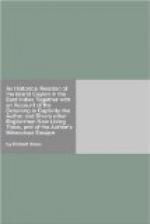[The curious Buildings of the Vaeos.] In places where there are no houses, and they can eat nothing belonging to the people, they will raise great Hills like Butts, some four or five or six foot high; which are so hard and strong, that it would be work enough to dig them down with Pick-Axes. The Chingulays call these Humbosses. Within they are full of hollow Vaults and Arches where they dwell and breed, and their nests are much like to Honeycombs, full of eggs and young ones. These Humbosses are built with a pure refined Clay by the ingenious builders. The people use this Clay to make their Earthen Gods of, because it is so pure and fine.
[The manner of their death.] This sort of creatures as they increase in multitudes, so they dy in multitudes also. For when they come to maturity they have wings, and in the Evening after the going down of the Sun, (never before) all those that are fledged and ripe, will issue forth in such vast numbers, that they do almost darken the Sky, flying to such an height, as they go out of sight, and so keep flying till they fall down dead at last upon the Earth. The Birds that tarry up late, and are not yet gone to roost, fly among them and make good Suppers of them.
The People in this Land never feed their Poultry. But they feed upon these Ants, which by scraping among the leaves and dirt they can never want; and they delight in them above Rice or any thing else. Besides all these Ants already mentioned, there are divers other distinct sorts of them.
[Bees of several kinds.] But we will proceed to a more beneficial Insect, the Bee. Of which there be three sorts. The first are the Meemasses, which are the right English Bees. They build in hollow Trees, or hollow holes in the ground, which the Vaeo’s have made. Into which holes the men blow with their mouths, and the Bees presently fly out. And then they put in their hands, and pull out the Combs, which they put in Pots or Vessels, and carry away. They are not afraid of their stinging in the least, nor do they arm themselves with any cloths against them.
[Bees that build on Trees like Birds.] The second are the Bamburo’s, larger and of a brighter colour than our English Bees. Their Honey is thin like water comparatively. They make their Combs upon limbs of Trees, open and visible to the Eye, generally of a great height. At time of year whole Towns, forty or fifty in company together will go out into the Woods, and gather this honey, and come home laden with it for their use.




